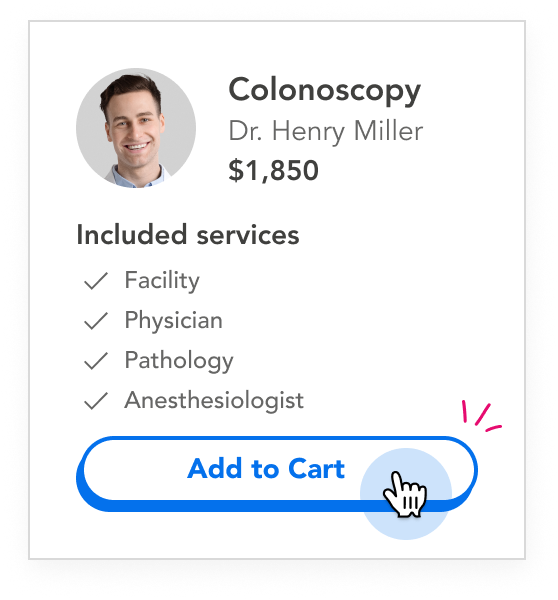Kidney Stone Removal (Lithotripsy) in the Chicago Region
Save by purchasing this procedure online.
Similar Procedures: Kidney Stone Removal (PCNL), Kidney Stone Removal by Incision (Nephrolithotomy)
National Average 16,004
Regional Average7,927Save $8,077
Financing Options
Promotional financing available when you pay with CareCredit. $200 minimum purchase. What is CareCredit?
MDsave and Your Insurance
Contact your insurance company directly to see if your purchase can count towards your deductible. Details
Offered by

Money Back Guarantee
We will refund your payment in full if you end up not needing your purchased procedure and do not receive care. Details
Get Care In Three Easy Steps
Compare Upfront Prices

Search by procedure and location to browse local providers and compare upfront pricing.
Buy Your Procedure

Pay for your procedure online or by calling (877) 461-2491. Or buy your procedure at the facility before your appointment is scheduled.
Receive Your Care

Follow the scheduling instructions given by your provider. Bring your voucher to your appointment.
Frequently Asked Questions
View All FAQsKidney Stone Removal (Lithotripsy) Cost in the Chicago Region
Save by purchasing this procedure online.
Kidney Stone Removal (Lithotripsy) Cost near Valparaiso, IN
Procedure Details
What is Kidney Stone Removal (Lithotripsy)?
Lithotripsy is the most common treatment for kidney stones. In the procedure, shock waves directed from outside your body are aimed at the stones. The shock waves break up the stones into small pieces that can exit your body through your urine.
When is Lithotripsy Used?
The procedure is used when kidney stones — often made of calcium or uric acid — are too large (usually 5 millimeters or larger) to exit your body through your urinary tract. The procedure is also used when large stones may be blocking your urine flow, or are causing bleeding or kidney infection. The procedure is also used if the kidney stones are causing pain that can't be helped by pain relievers.
How Do You Prepare for Kidney Stone Removal?
Your doctor likely will ask you to stop taking blood thinners like aspirin and ibuprofen in the days before the procedure. Those drugs decrease your blood's ability to clot.
You also may be instructed not to eat or drink anything in the several hours before the procedure.
What Can You Expect Before Kidney Stone Removal?
You will put on a hospital gown and lie on an exam table. A water-filled cushion will be positioned underneath you, near the area to be treated. The medical providers performing the test will position your body so they can easily target the stones with the shock waves.
You will be given medicine to help you relax and will be given local or regional anesthesia in the area of your body where the procedure will take place. In some situations, you may be given general anesthesia, which means you will be asleep during the procedure. You'll also be given antibiotics to prevent infection.
What Can You Expect During the Procedure?
Your health care providers will use x-rays and ultrasound to determine where the kidney stones are located. They will then direct the high-energy sound waves, also called shock waves, at the kidney stones from outside your body. If you've been given local anesthesia, you may notice a tapping feeling but will feel no pain. The treatment usually takes 45 minutes to an hour.
What Can you Expect After Kidney Stone Removal?
In most cases, patients will go home the day of the procedure. You likely will stay in the medical facility's recovery room for an hour or two afterwards.
Most people can resume normal activities a day or two after the procedure.
Your doctor may give you a urine strainer to catch the tiny bits of stone that will likely pass in your urine in the days or weeks afterwards. Those stones can be tested to better understand your condition.
In the several days after the procedure, you may notice side effects like blood in your urine and some pain. Taking over-the-counter pain medication and drinking plenty of fluids will help the pain.
What are the Advantages of this Treatment?
The primary advantage of lithotripsy is that it doesn't require an incision or more complicated surgery to remove the stones. Those alternative kidney stone treatments mean longer recovery times, longer hospital stays and higher risks of complications.
How Successful is Lithotripsy?
About 70 to 80 percent of patients who are appropriate candidates for the surgery will be free of kidney stones three months after the procedure. The highest success rates are among patients with the smallest kidney stones. In general, people with stones that are less than 1.5 centimeters in diameter are the best candidates for the procedure.
Does the Procedure Work for All Kidney Stones?
No. Some people who have the procedure may still have the kidney stones afterwards. Most often, those are people who have larger stones. Also, some patients are not good candidates for this procedure. They include:
- pregnant women, because the shock waves could harm the fetus
- people with bleeding disorders
- people with infections
- people with skeletal abnormalities
- people who are very obese
What are Some Other Procedures that Can Help Treat Kidney Stones?
For cases where the stones can't be broken apart by lithotripsy, other procedures might help. They include:
- A procedure in which a doctor makes a small incision and inserts a small tube called an endoscope into the kidney.
- A procedure in which a doctor inserts a small lighted tube called a ureteroscope into the bladder and ureter, then uses a device inserted into the tube to grab the stone and remove it.
- A procedure in which a doctor uses a special scope to insert a stent into the urinary track to help the stones pass through the tract more easily.
- Open surgery (rarely)
https://medlineplus.gov/ency/article/007113.htm
https://www.kidney.org/atoz/content/kidneystones_shockwave
https://www.uofmhealth.org/health-library/hw204232
https://www.hopkinsmedicine.org/healthlibrary/test_procedures/urology/lithotripsy_92,p07720
https://my.clevelandclinic.org/health/treatments/16582-shockwave-lithotripsy
Patient Reviews
5.0
What did you like most about using MDsave?
The hospital seeing I had paid and they took it from there. Basically one step process for me, no wondering what I do next.
What could we do to improve?
Honestly don’t know. First time using this process.
What did you like most about using MDsave?
I wouldn't have been able to have my surgery done
What could we do to improve?
Nothing
What did you like most about using MDsave?
Very easy to use.
What could we do to improve?
N/A
What did you like most about using MDsave?
It help save money
What could we do to improve?
Have more people to speak Spanish
What did you like most about using MDsave?
It just helped so much.
What could we do to improve?
I am not sure. You have helped so much. I am greatful that you are here to help.
Procedures
© Copyright 2025 MDsave Incorporated.
All Rights Reserved.



